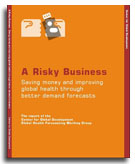As more money is made available for the development and purchase of products that are needed to diagnose, prevent and treat leading causes of death and disability in developing countries, the need to improve demand forecasting comes into sharp relief. Shortcomings in demand forecasting increase risks for suppliers, resulting in higher costs, supply shortages and concerns about the long-term viability of investing in R&D for health products that would benefit the developing world. Demand forecasting also limits donors' and national health programs' ability to spend their aid dollars effectively to improve public health and save lives. Achieving better demand forecasts for - and better access to - critical medical technologies in the developing world requires collaboration and investment from all of the key stakeholders in the value chain for these products, and would benefit each of them in turn.
A Risky Business: Saving Money and Improving Global Health through Better Demand Forecasts

CGD convened the Global Health Forecasting Working Group to study the challenges surrounding demand forecasting. After a year of research and deliberation and further consultation among a broad set of interested parties, the group concluded that better forecasting requires wider sharing of the risk involved in producing drugs and aligning incentives among those who influence market dynamics through three mutually enforcing actions:
- Improving the capacity to develop credible forecasts by taking forecasting seriously
- Mobilizing and sharing information about product demand in a coordinated way through the establishment of an infomediary
- Adopting a broad range of contractual arrangements
Read the working group's report or policy brief to learn more.

